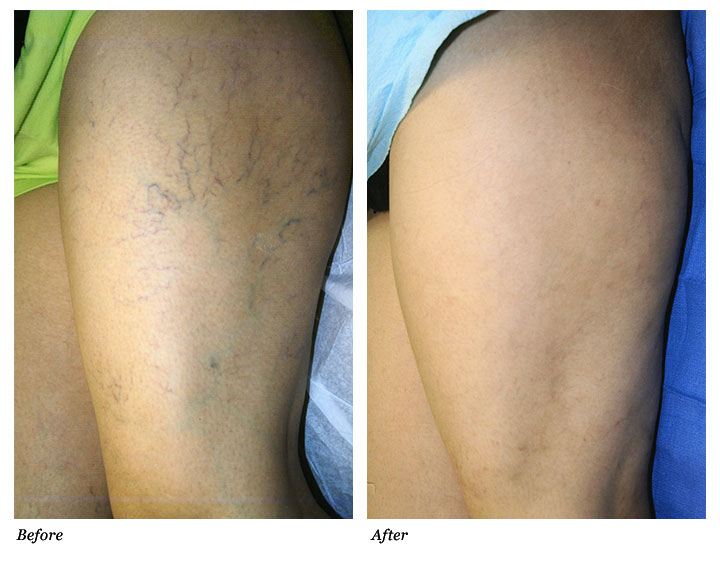Sclerotherapy is a non-surgical injection therapy used to eliminate varicose and spider veins and is considered the primary treatment for small-vessel varicose disease, such as spider veins. During sclerotherapy affected vessels are injected with a sclerosant solution, which causes the vessel to collapse. As a result the treated vessel can no longer hold blood and shrinks, ultimately disappearing. Performed in-office, sclerotherapy is a relatively quick procedure and takes anywhere from 20 to 30 minutes depending on the number of spider/varicose veins being treated and their size.

Approximately one injection is administered for every inch of spider/varicose vein, varying anywhere from five to forty injections per treatment session.
Although you should take it easy for at least two days following the procedure, sclerotherapy generally does not require any recovery period. After sclerotherapy treatment, external compression is applied to the treated areas and patients are encouraged to wear elastic bandages or support stockings for a few days, which aid in the closure of treated veins.
Benefits of Sclerotherapy
Sclerotherapy can result in the elimination of unwanted varicose and spider veins making the skin of your legs appear younger, clearer, and more healthy-looking. Results are quite remarkable often even after just one procedure. Sclerotherapy of varicose and spider veins is a relatively simple procedure that requires no anesthesia.
- No downtime-patients can immediately resume work and non-vigorous activity.
- Little to no discomfort.
- Generally, excellent overall improvement in the appearance is achieved.
- Sclerotherapy is a safe, time-proven procedure.
Sclerotherapy may also improve the associated symptoms of varicose and spider veins, such as mild pain and itchiness. The mildness of the sclerosing agent has made sclerotherapy a relatively painless procedure with very predictable results. Although sclerotherapy will rid the noticeable veins permanently, it’s important to remember that the sclerotherapy treatment will not prevent new spider veins from occurring.
Frequently Asked Questions About Sclerotherapy:
What is the recovery time for sclerotherapy treatment?
Daily activity will not be significantly limited in any other way from sclerotherapy treatment. Walking is encouraged to prevent clotting in the deep veins of the legs. However, during the period of time to complete your treatment program, prolonged sitting and standing should be avoided, as should squatting, heavy weight lifting and “pounding” type exercises, including jogging.
What are the common side effects of sclerotherapy?
Serious medical complications from sclerotherapy treatment are extremely rare when the procedure is performed by a qualified practitioner. Risks can include the formation of blood clots in the veins, severe inflammation, adverse allergic reactions to the sclerosing solution and skin injury that could leave a small but permanent scar.
Are multiple sclerotherapy treatments necessary?
Sclerotherapy can enhance your appearance and your self confidence, but it’s unrealistic to believe that every affected vein will disappear completely as a result of treatment. After each sclerotherapy session, treated veins will appear lighter. Two or more sessions are usually required to achieve optimal results.
You should also be aware that the procedure treats only those veins that are currently visable; it does nothing to permanently alter the venous system or prevent new veins from surfacing in the future.
Before you decide to have sclerotherapy, think carefully about your expectations and discuss them with your doctor.
Possible Risks and Complications to Sclerotherapy
While the percentage of possible complications of sclerotherapy is low, certain side effect my arise among small percentage of patients. However, these are usually relatively minor and should fade away over time. The most common side effect of sclerotherapy is skin discoloration and bruising. Bruising will typically disappear within 1-2 weeks following the procedure. Another common complication is pigmentation irregularity – brownish splotches on the affected skin that may take months to fade, and sometimes up to a year. Other problems that can occur are “telangiectatic matting,” in which fine reddish blood vessels appear around the treated area, requiring further injections. Generally, any discoloration of the skin will subside over time, sometimes lasting several months and in a small percentage of individuals may be permanent. The use of compression garments after sclerotherapy treatment will decrease the incidence of hyperpigmentation and can improve results.
You can reduce the risks associated with treatment by choosing an adequately trained physician in sclerotherapy and is well versed in the different types of sclerosing agents available. A qualified doctor can help you select which type of sclerosing medication is most appropriate for your needs.
Sclerotherapy should not be performed on those who are pregnant or nursing, have a history of allergic reaction to sclerosant, or who have blood clots or inflammation in the deep leg veins. Candidates with certain medical conditions such as blood-borne, infectious, and cardiac diseases, as well as those with high blood pressure or diabetes, may not be able to receive sclerotherapy.
